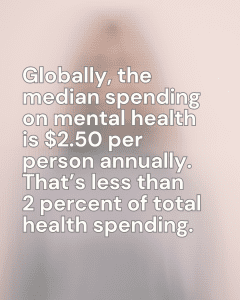One of the few good things to come out of the global pandemic is an increased focus on – and appreciation for – mental health. That growing awareness has driven research into everything from eating disorders to schizophrenia to bipolar disorder.
A study published earlier this year, for example, showed that the prevalence of bipolar disorder in adolescents and young adults has grown steadily every year since 1990.
“Bipolar disorder is the third leading cause of the burden of mental disorders among adolescents and young adults aged 15–24 years, and the burden has continued to grow since 1990 with no evidence of a reduction,” the study’s authors wrote. “Without intervention, this burden is likely to keep increasing. Specifically, inadequate global mental capital and unmet treatment needs among many adolescents with bipolar disorder may worsen this burden. The current low global median spending on mental health (US$2.50 per person annually, less than 2% of total health spending) may be a major reason for the large gap between young people’s mental health needs and the availability of preventive interventions.”
Better awareness remains the first – and most effective – step toward treatment. And celebrities coming out – like Faye Dunaway did in a new documentary – can only help.
The Journal of Clinical Psychiatry has published some of the latest research this year. This week, we’re offering summaries of some of those – along with links – for further review.
Offspring of Bipolar Parents Show Elevated Cardiovascular Risk
In June JCP published a paper that explores the prevalence and heritability of cardiovascular risk factors (CVRFs) and metabolic syndrome (MetS) in the offspring of parents with bipolar disorder (BD).
This research follows earlier studies that suggested first-degree relatives of those with serious mental illnesses have a higher prevalence of type 2 diabetes (T2D), hypertension, and other CVRFs.
Researchers wanted to plug some knowledge gaps about the vascular-bipolar connection by comparing MetS components — central obesity, elevated blood pressure, elevated glucose, and dyslipidemia — among three groups:
- Offspring of a parent with BD with a mood disorder (affected high-risk offspring).
- High-risk offspring without a mood disorder (unaffected high-risk offspring).
- And unaffected offspring of control parents.
The research team included 529 individuals from the Pittsburgh Bipolar Offspring Study (BIOS). That project launched in 2002, with MetS assessments starting in 2013. The study included 116 parents with BD and their 198 offspring, as well as 83 control parents with 132 children. Parents with BD met DSM-IV criteria for BD-I/BD-II. Researchers grouped control parents by age, sex, and neighborhood and excluded if they or their first-degree relatives had BD.
Finally, the researchers worked with physical and metabolic assessments, including in-home blood tests, anthropometric measurements, and personal and family medical history questionnaires.
Key findings include a significantly higher prevalence of MetS among parents with BD compared to control parents. Specifically, slightly more than 59 percent of parents with BD met the International Diabetes Federation (IDF) criteria for MetS. This stood in stark contrast to 41.5 percent among the control group. Among offspring, affected high-risk offspring had a higher prevalence of MetS compared to unaffected high-risk and control offspring. But when controlling for age and socioeconomic status, the offspring’s differences appeared to be negligible.
Sensitivity analyses controlling for psychotropic medication and second-generation antipsychotics supported these findings. Exploratory analyses indicated that offspring mood disorder by parental mood disorder interaction significantly affected waist circumference and HDL-C levels, highlighting potential biological mechanisms.
Wrapping up, the authors concluded that affected high-risk offspring of parents with BD might have an elevated cardiovascular risk, necessitating more assertive monitoring and intervention.
But socioeconomic status – as it does with most things – notably influenced outcomes, suggesting the need for considering socioeconomic factors in preventative and treatment approaches for these high-risk groups.
A Safe, Effective Treatment for Bipolar Depression
Bipolar disorder affects more than 50 million people worldwide, necessitating novel, safe interventions. Unlike unipolar depression, bipolar disorder involves manic or hypomanic episodes.
Existing FDA recommendations for bipolar depression include five atypical antipsychotics, one combined with an antidepressant. Antidepressants alongside mood stabilizers offer minimal improvements and risk triggering manic episodes, highlighting the need for new treatments.
One such treatment emerged when regulators signed off on repetitive transcranial magnetic stimulation (rTMS) for the treatment of unipolar depression in 2007. And caregivers have since extended its use to obsessive-compulsive disorder, anxious depression, and smoking cessation. It’s also shown potential to treat bipolar disorder.
The biggest selling point of rTMS is that it lacks the systemic long-term side effects of pharmacologic agents. And early rTMS reports in bipolar depression show promise, particularly when combined with mood stabilizers to mitigate the risk of manic episodes.
However, varied protocols in rTMS studies pose their own challenges. Researchers shut down one high-profile rTMS trial using intermittent theta burst stimulation because of a lack of results. This suggests that frequency parameters play a crucial role.
Other studies also showed limited efficacy, indicating potential moderation by antipsychotics but not by mood stabilizers or antiepileptic drugs.
A more recent retrospective analysis showed promise. It revealed a 77 percent response rate and a 41 percent remission rate with rTMS in bipolar disorder, outperforming unipolar depression outcomes. An open-label, prospective trial further supported rTMS effectiveness in bipolar depression. That trial achieved high remission and response rates without serious adverse events. Significant findings included differential treatment outcomes influenced by age and concurrent medication with lamotrigine or lithium. Suicidal ideation also improved, backing up other research on rTMS protocols targeting suicidality.
This study, using standard rTMS protocols for unipolar depression, provides a comparative framework and suggests that rTMS could be a potentially effective treatment for bipolar depression. But the researchers add that further large-scale, randomized controlled trials could help optimize treatment protocols and confirm these findings.
Intranasal Ketamine Appears to Treat Depression
Primary mood and alcohol use disorders (AUD) are major psychiatric diagnoses among suicide victims. Glutamatergic dysfunction appears to be a common link between mood disorders, alcohol dependence, and suicidality.
Now ketamine has shown promise in treating depression and AUD, and improving abstinence in AUD patients. But direct research on the anesthetic’s effects on AUD patients remains scarce, despite the high comorbidity between AUD and mood disorders.
This study investigated the antisuicidal and antidepressant effects of intranasal (IN) ketamine in medication-free patients at high risk for suicide during hospitalization. The double-blind, randomized, placebo-controlled trial included participants with MDD and BD, with efforts to include those with comorbid AUD. The researchers theorized that IN ketamine would have rapid antisuicidal effects, especially in those with comorbid AUD.
Researchers randomized more than two dozen patients, giving them either 50 mg of IN ketamine or a saline placebo. Primary outcomes measured were changes in suicidal ideation (SSI) and depressive symptoms (MADRS).
Results showed that while IN ketamine significantly improved depressive symptoms, it did not significantly reduce suicidal ideation compared to placebo. However, researchers observed a trend toward better antisuicidal response in patients with comorbid AUD.
Patients without comorbid AUD showed correlated improvements in depression and suicidal ideation, whereas those with AUD showed more variable responses. This variability may be due to differences in glutamatergic function from chronic alcohol use. IN ketamine was well tolerated, with minimal adverse effects, suggesting its potential as a rapid-acting antidepressant.



